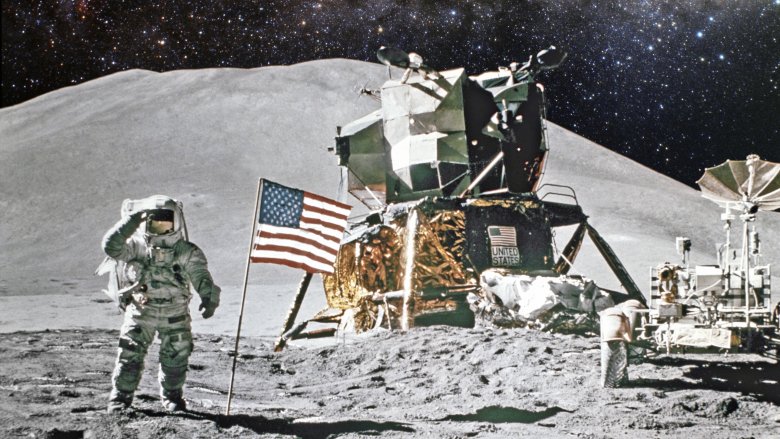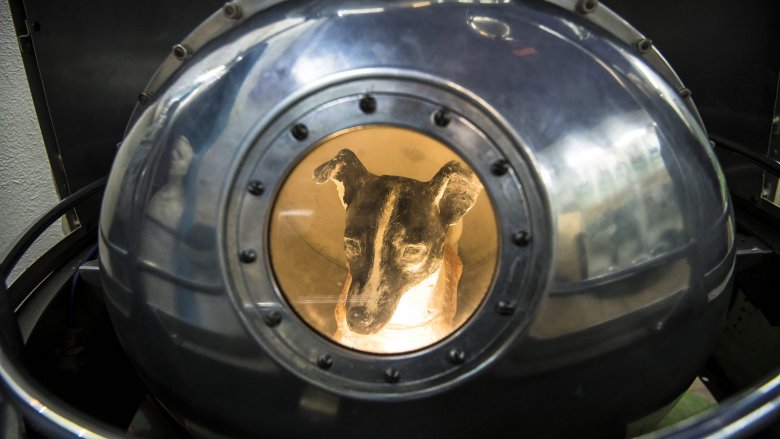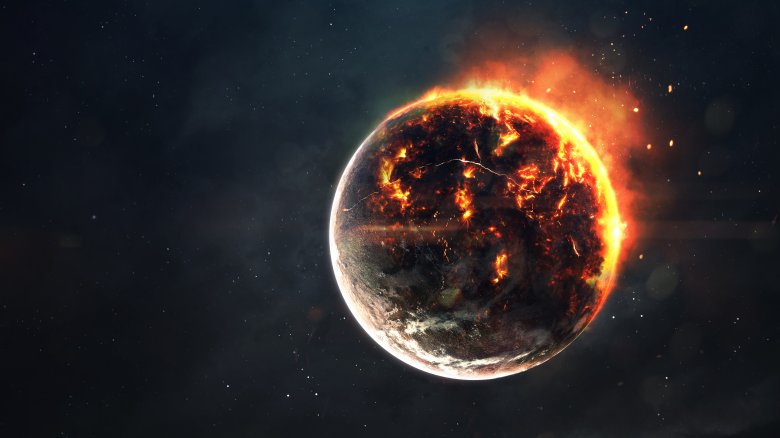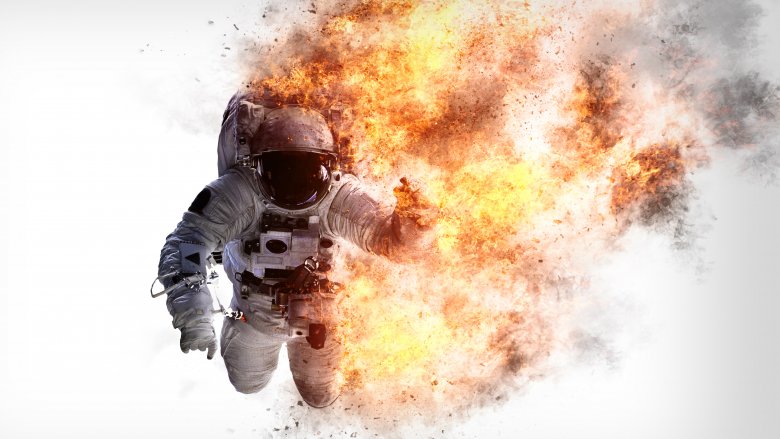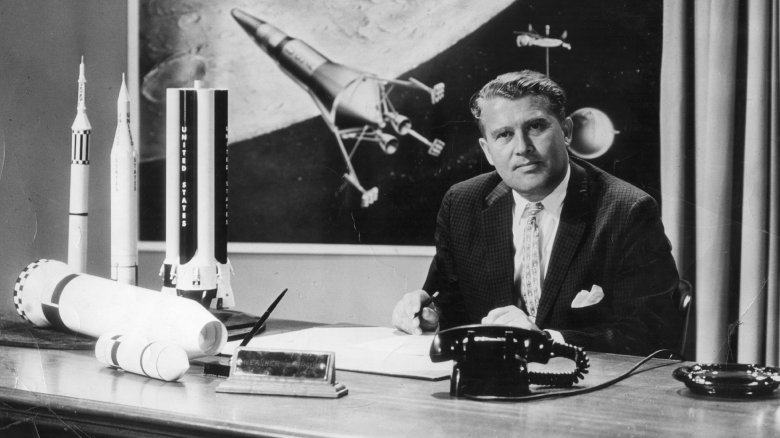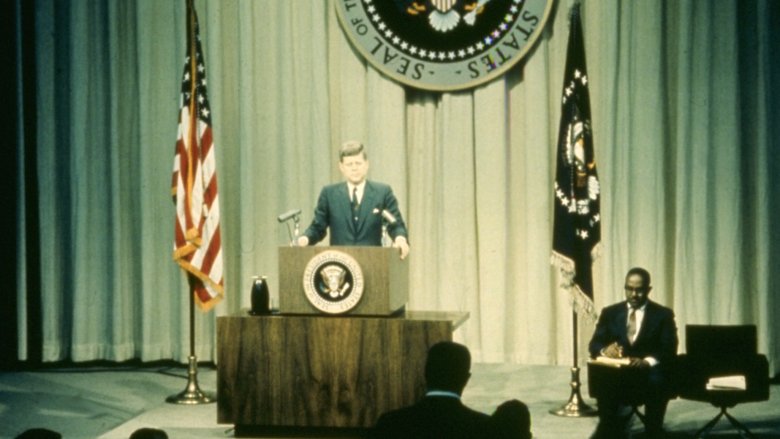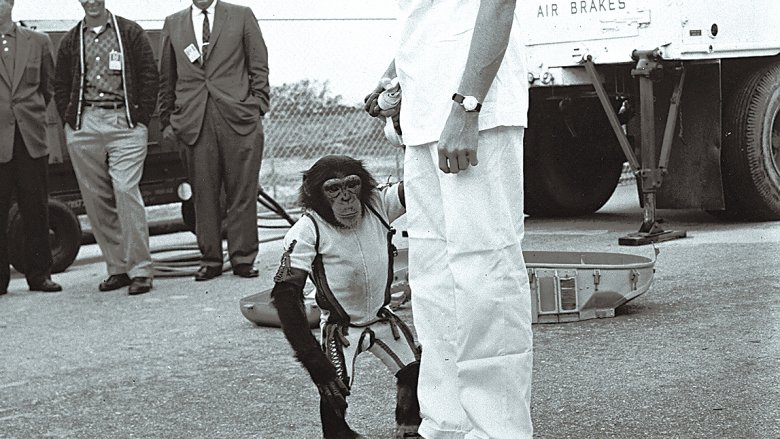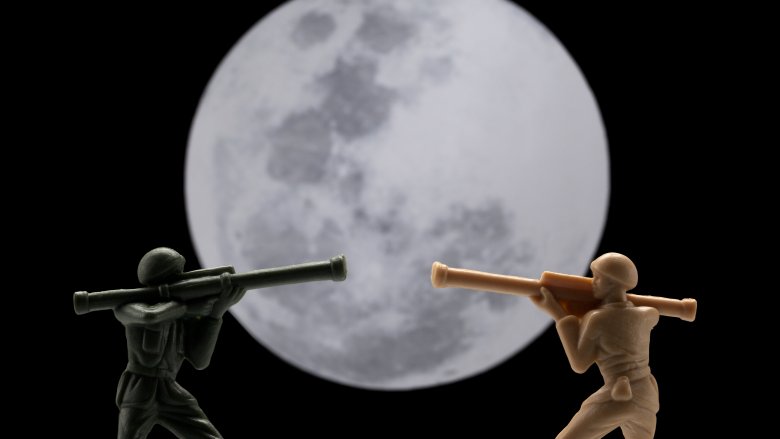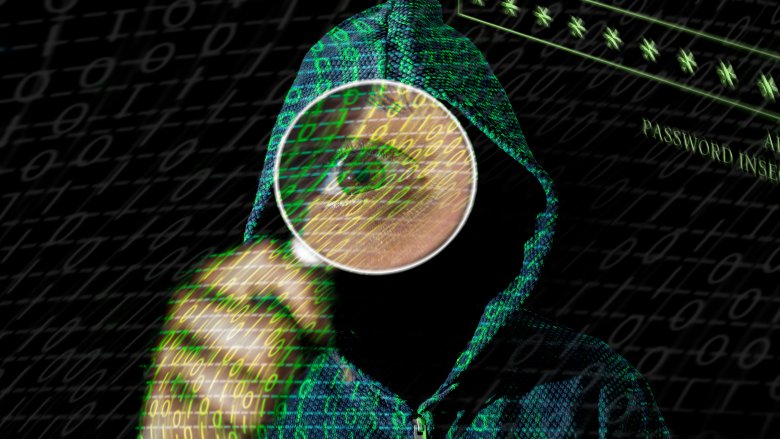Messed Up Things That Happened During The Space Race
We may receive a commission on purchases made from links.
If one good thing came out of the long, bitter conflict between the United States and the Soviet Union, it was the space race, where two global superpowers lowered their arms to engage in a friendly competition, for the good of humankind, for the cause of science, for ... oh, wait.
In real life, while the space race certainly led to some amazing discoveries and while getting a man on the Moon is probably the most incredible achievement in human history, what happened behind the scenes was more like a messed-up Star Trek episode. While scientists on both sides worked like crazy, their competing governments spat at each other like two swollen-headed macho men trying to prove who was boss. Nationalism ran high, pettiness was rampant, innocent animals were abused, and at one point someone even wanted to nuke the Moon. Yikes. While the human species can rightfully take pride in the scientific advances that happened during the race to the stars, it's worth remembering that some messed-up stuff went down, too.
The first space dog died in the most horrific way possible
The first Earthling to orbit everyone's favorite blue sphere was neither a human being nor a chimpanzee. Instead, it was a stray dog named Laika, who rode solo aboard the Soviet Union's Sputnik 2 in 1957. Laika was celebrated as a canine hero, but she didn't come home to treats, belly rubs, or even a nice nap. Approximately a week after taking off, the USSR announced that she had died "painlessly" in space ... by herself, in a tiny metal vessel. Depressing much?
This fictionalized account of Laika's death would be gruesome enough, but the hidden truth was even worse. According to the BBC, Laika's conditions in the Sputnik 2 were abominable. She was chained up to the point of being almost immobile, and her food was gelatinized. When the spaceship launched, Laika's heart rate sensors spiked like crazy, and as the poor dog got increasingly freaked out, the ship's interior heated up so fast that she died only a few hours after takeoff. So yes, Laika did make history, but the details of the whole thing are fairly disturbing.
The USA totally wanted to nuke the Moon
Many action movies feature the archetype of a cigar-chomping general as the bad guy, whose solution to any problem — whether it's aliens, a hippie protest, or a son-in-law who transforms into a green monster — is to drop a nuke on it. Never a good idea, right?
Well, Vice says after Russia successfully launched Sputnik, the U.S. Air Force got so spooked that they drafted up Project A119, a top secret plan to shoot a nuclear missile at the Moon. Why? To scare the Soviets, obviously! Childish as it might sound today, the U.S. seriously wanted to make a mushroom cloud so big and puffy that everyone on Earth would see how mighty, strong, and fearsome those U.S. nukes really were. Before any of this craziness saw the light of day, someone must have watched The Day the Earth Stood Still and realized that even if shooting apocalyptic weapons into space didn't piss off every alien race in the galaxy, Earthlings were more likely to hide in terror than give each other high-fives about how "cool" nukes were. By 1967, space nukes got banned by the United Nations' Outer Space Treaty, and the lunar surface has been safe ever since.
The cosmonaut who went on a death mission
Going up in space is always going to be a scary proposition, but it'd be a whole lot scarier if you knew your government was sending you up there to die.
In 1967, according to NPR, the Soviet Union wanted to celebrate the 50th anniversary of the Communist Revolution in grand fashion by having an astronaut fly up to the stars, dock with another space vessel, then swap vessels and come home. Impressive? Sure, in theory. The problem? The first spaceship, the Soyuz 1, was a piece of junk, with 203 documented structural problems. Anytime someone tried to broach this matter, they got fired, demoted, or sent to Siberia. So everything kept moving ahead, even though everyone — including Vladimir Kamarov, the cosmonaut scheduled for the flight — knew it was probably going to blow up in space.
Despite this, Kamarov refused to call out sick because his only backup was his best friend Yuri Gagarin, the first man in space. So Kamarov knowingly went on a suicide mission to prevent Gagarin from being forced to do the same. As the Soyuz 1 crashed back to Earth, Kamarov was allegedly recorded crying out in rage at everyone who had allowed his mission to occur.
The U.S. space program hired Nazi scientists
After World War II ended, what happened to all those Nazi scientists? Horrifyingly enough, a lot of them were hired by the U.S. space program, according to Business Insider. Scientists like Wernher von Braun (above) and Hermann H. Kurzweg went from Nazi laboratories straight to NASA, heading up Moon missions and becoming chief researchers. Another notable figure was Hubertus Strughold, a man often celebrated as the so-called "Father of Space Medicine," even though his past career in Germany may have involved human experimentation.
Facts are facts, and these hirings were not an accident. As creepy as it sounds, the U.S. government was fully aware of where these men came from and what they had done. The Nazi space scientists had their records cleared and whitewashed in a program called Operation Paperclip, with many of the more disturbing details only being released years later, a story thoroughly documented in Wayne Biddle's book Dark Side of the Moon.
JFK tried to get both sides to work together ... and then got shot
Alternate histories have certainly led to some great TV episodes, but they're also a popular drinking conversation for historians. The JFK assassination often comes up in these chats, and one key reason is because back in 1963, according to History, John F. Kennedy did something shocking. Speaking to the United Nations, he pleaded for the U.S. and the USSR to stop beating each other up, to instead join forces in the mission to put a man on the Moon.
Yes, this really happened. JFK hit on every negative point of the space race, pointing out that having a competition to the Moon wasted resources that would be better spent working together, and even arguing that getting into outer space should be an achievement for all of humanity, not just some nationalist bragging point. Kennedy earned a lot of acclaim for the speech, but the crazy part is the Soviets might have been down for it. Sure, they turned it down at first, but according to Space Daily, they were moving to accept the offer when JFK was shot in Dallas. Lyndon B. Johnson and the Soviets didn't trust each other, so JFK's potentially huge deal fell to pieces, leaving nothing but all those alternate history theories in its wake.
Space chimp electrocution
What happened to Laika the space dog was horrifying, but when it came to animal abuse, the USA got its hands just as dirty. Everyone fondly remembers Ham and Enos, the first two "space chimps," but no one talks about the fact that forcing those chimpanzees into space vehicles led to inhumane training procedures. No classroom, no desks, no kindly teachers: According to The Atlantic, Ham and Enos were conditioned to operate spacecraft through the use of painful electric shocks delivered through the soles of their feet every time they messed up a procedure.
During one particularly brutal flight, an equipment malfunction caused Enos to be shocked 76 times, even though he continued to follow protocol. After undergoing this torture, the chimpanzee's space capsule landed in the wrong spot, leaving him trapped inside for over three hours. By the time people found his vessel and freed him, he'd already torn up the inside in a panic, and even ripped out his still-inflated catheter. In the year following this incident, Enos died of dysentery.
Cosmonauts who got doctored out of history
Long before photoshop editing became a popular teenage prank, people still doctored photos in all kinds of wacky ways. Something that wasn't a joke, though, was the way the Soviet Union deliberately altered the historical record. According to The Atlantic, officials sometimes went as far as airbrushing real cosmonauts out of photographs. What happened to these erased people? While the USSR's violent reputation can't help but bring horrible theories to mind, Wired says the erased cosmonauts were simply men who were fired or who had been disqualified for health reasons, rather than being the victims of secret trips to the back alley. Still, having them erased? A bit much, no?
This all reeks of 1984, but the real Soviet Union was a bit clumsier than Orwell's Big Brother, as the USSR made the mistake of releasing both the doctored and un-doctored photos at separate times. Yes, people noticed.
The U.S. military wanted boots on the Moon
Even though Kennedy's concept of a joint American-Soviet lunar program never came to pass, JFK at least succeeded in reframing the Moon race as a quest for scientific accomplishment rather than a battle for dominance between two feuding countries. History could have been much different, though, if Project Horizon had come to pass. According to the National Museum of the United States Army, the Army was hoping for a military outpost on the Moon by 1966. Masterminded by Lieutenant General Arthur G. Trudeau, this remarkably hawkish project focused on being able to deploy nuclear weapons from the lunar surface down to Earth. The underground Moon base would be powered by two nuclear reactors and staffed by 42 soldiers doing one-year tours. Any scientific benefits to this military outpost were seen as a nice bonus, but not the main objective.
Today, this sounds like the setup for a new Quake game, but back in the 1960s, Project Horizon was dead serious. Soon, though, it became apparent just how insanely expensive a Moon outpost loaded with nuclear missiles would be, and it didn't help matters when funds got railroaded into the Vietnam War. By 1967, the United Nations laid some ground rules in a space treaty and ended the discussion.
The National Security Agency (yes, really) said hacking was a bad idea
Often, new technology is great. But sometimes, it can be ridiculously dangerous, as the Terminator movies have been trying to tell everybody for decades. Newsweek says that back in 1959, U.S. intelligence developed equipment capable of tampering with orbiting satellites, potentially even giving them the ability to hack the control systems of Russian space vehicles. Everyone was enthusiastic about this idea, and even went so far as to point it at a Soviet satellite ... until the NSA saved the day.
Yes, that's the same NSA that some have compared to a James Bond villain in recent years, but back then, someone from the organization thought hacking into satellites would set a horrible precedent because other countries would start doing the same thing and then no one would use satellites anymore. Shortly afterward, the technology was disabled. Somewhere in here there's a moral about learning the lessons of history or ... something. Maybe a time travel machine will help.
Racism at NASA
NASA still has a diversity problem today, according to Science Magazine, but things were way more messed up back in the space race days. Perhaps the most damning piece of evidence in this regard was the 1973 firing of Ruth Bates Harris, NASA's deputy assistant administrator for equal opportunity. Why was Harris removed? As reported by the New York Times, Harris had continually slammed the agency for not hiring enough women or minority workers.
Yes, that's right: Instead of just hiring more women/minorities, NASA responded to charges of racism and sexism by firing their highest-ranking black female official. You can't make this stupid stuff up. These sorts of racist/sexist practices were unfortunately all too common at the time. A 1973 issue of Science Magazine says NASA's diversity problem drew the ire of both women's rights groups and civil rights organizations after Harris' removal, but it doesn't seem to have been fixed quite yet.
